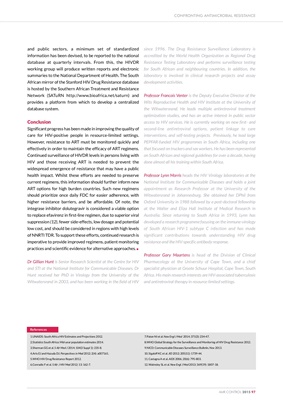
therapies, indicating a wide population-based susceptibility
to this drug class.
Conclusion
Significant strides have been made in improving the quality
of care for HIV-infected people in resource-limited settings.
However:
‰ We need surveillance;
‰ We don't fully understand the consequence for public
health programmes of HIVDR - transmitted or acquired;
‰ We need better tracking of patients;
‰ We need new generations of drugs may change the way
we do business. l
Dr Malebona Precious Matsoso, BPharm, PgDipHM, LLM was
appointed Director-General of the National Department of
Health of South Africa in June 2010. She was previously the
Director of Public Health, Innovation and Intellectual Property
Programme at the World Health Organization, responsible for the
implementation of the Global Strategy and Plan of Action on
Public Health, Innovation and Intellectual Property. She also
served as Director of Technical Cooperation for Essential Drugs
and Traditional Medicine for the WHO. She served on several
advisory panels locally and internationally. She was a member of
the National Research Ethics Council in South Africa, the WHO
Ethics Review Committee. Prior to her international assignments,
she was the Registrar of Medicines at the Medicines Control
Council in South Africa and served on the Secretariat of the
Southern African Development Community (SADC)
harmonization initiative. She is currently a member of the
Executive Board of the World Health Organization.
CONFRONTING ANTIMICROBIAL RESISTANCE
AMR CONTROL 2015 97
References
1.africa SS. Mid-year population estimates 2014: Statistics South Africa, 2014.
2.bor J, Tanser F, Newell ML, Barnighausen T. In a study of a population cohort in South
Africa, HIV patients on antiretrovirals had nearly full recovery of employment. Health
affairs 2012; 31(7): 1459-69.
3.gupta RK, Jordan MR, Sultan BJ, et al. Global trends in antiretroviral resistance in
treatment-naive individuals with HIV after rollout of antiretroviral treatment in resourcelimited
settings: a global collaborative study and meta-regression analysis. Lancet 2012;
380(9849): 1250-8.
4.arts EJ, Hazuda DJ. HIV-1 antiretroviral drug therapy. Cold Spring Harbor perspectives in
medicine 2012; 2(4): a007161.
5.who. WHO Drug Resistance Report2012.
6.sunpath H, Wu B, Gordon M, et al. High rate of K65R for antiretroviral therapy-naive
patients with subtype C HIV infection failing a tenofovir-containing first-line regimen. Aids
2012; 26(13): 1679-84.
7.van Zyl GU, Liu TF, Claassen M, et al. Trends in Genotypic HIV-1 Antiretroviral Resistance
between 2006 and 2012 in South African Patients Receiving First- and Second-Line
Antiretroviral Treatment Regimens. PloS one 2013; 8(6): e67188.
8.doh. Joint Review of HIV, TB and PMTCT Programmes in South Africa - April 2014.
2014.
9.who. World Health Organization Global Strategy for the Surveillance and Monitoring of
HIV Drug Resistance2012.
http://apps.who.int/iris/bitstream/10665/77349/1/9789241504768_eng.pdf (accessed.
10. Conradie F, Wilson D, Basson A, et al. The 2012 southern African ARV drug resistance
testing guidelines. S Afr J HIV Med 2012; 13: 162-7.
11. Hoffmann CJ, Charalambous S, Sim J, et al. Viremia, resuppression, and time to
resistance in human immunodeficiency virus (HIV) subtype C during first-line
antiretroviral therapy in South Africa. Clinical infectious diseases : an official publication of
the Infectious Diseases Society of America 2009; 49(12): 1928-35.
12. Marconi VC, Sunpath H, Lu Z, et al. Prevalence of HIV-1 drug resistance after failure of a
first highly active antiretroviral therapy regimen in KwaZulu Natal, South Africa. Clinical
infectious diseases: an official publication of the Infectious Diseases Society of America
2008; 46(10): 1589-97.
13. Orrell C, Walensky RP, Losina E, Pitt J, Freedberg KA, Wood R. HIV type-1 clade C
resistance genotypes in treatment-naive patients and after first virological failure in a
large community antiretroviral therapy programme. Antiviral therapy 2009; 14(4): 52331.
14. El-Khatib Z, Ekstrom AM, Ledwaba J, et al. Viremia and drug resistance among HIV-1
patients on antiretroviral treatment: a cross-sectional study in Soweto, South Africa. Aids
2010; 24(11): 1679-87.
15. Sigaloff KC, Hamers RL, Wallis CL, et al. Second-line antiretroviral treatment
successfully resuppresses drug-resistant HIV-1 after first-line failure: prospective cohort
in Sub-Saharan Africa. The Journal of infectious diseases 2012; 205(11): 1739-44.
16. Hosseinipour MC, Gupta RK, Van Zyl G, Eron JJ, Nachega JB. Emergence of HIV drug
resistance during first- and second-line antiretroviral therapy in resource-limited settings.
The Journal of infectious diseases 2013; 207 Suppl 2: S49-56.
17. Waters L, Bansi L, Asboe D, et al. Second-line protease inhibitor-based antiretroviral
therapy after non-nucleoside reverse transcriptase inhibitor failure: the effect of a
nucleoside backbone. Antiviral therapy 2013; 18(2): 213-9.
18. Paton NI, Kityo C, Hoppe A, et al. Assessment of second-line antiretroviral regimens for
HIV therapy in Africa. The New England journal of medicine 2014; 371(3): 234-47.
19. Castagna A, Danise A, Menzo S, et al. Lamivudine monotherapy in HIV-1-infected
patients harbouring a lamivudine-resistant virus: a randomized pilot study (E-184V study).
Aids 2006; 20(6): 795-803.